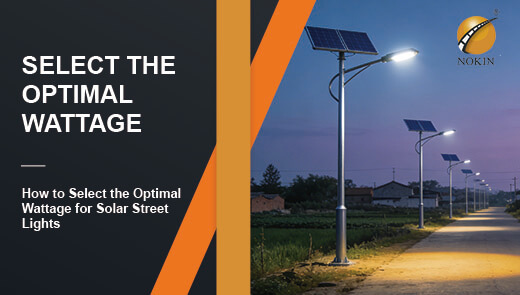Solar Street Lights for Residential Areas
Traditional residential area street lights have long been confronted with four core pain points, causing great disturbance to property management and homeowners. First, the wiring cost is high. Second, it relies on power supply from the power grid. Third, the operating expenses are continuously incurred. Fourth, the maintenance process is complex. The emergence of solar street lights precisely addresses these problems. It does not require complex grid wiring and operates entirely on solar energy, achieving "zero electricity expenditure". Meanwhile, its independent off-grid operation feature enables it to function normally even during power outages, providing continuous lighting for the community. Solar street lights have become the preferred solution for optimizing lighting systems.
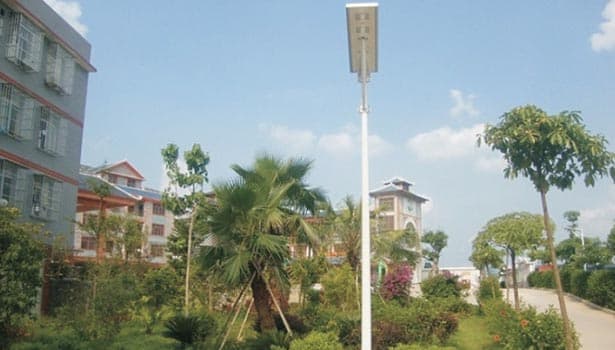
What are Solar Street Lights for Residential Use?
Residential solar street lights are an independent system that converts solar energy into electricity to provide lighting for public areas in residential regions. It is mainly composed of five core components, all of which work in coordination to ensure stable operation. During the day, the solar panels are responsible for generating electricity and storing it in the battery. When the light dims, the controller automatically switches to discharge mode to supply power to the lights. The next day when it gets light, the solar street light system switches back to charging mode. In this way, the solar street lights can keep operating continuously.
7 Advantages of Using Solar Street Lights in Residential Areas
Quick Installation and Minimal Disturbance
There is no need to dig the road surface to lay cables, which is especially suitable for the renovation of existing residential areas. The installation of traditional street lights takes 3 to 5 days per light, while solar street lights are quick to install and do not affect residents' travel and parking during the construction process, significantly reducing community conflicts during the renovation period.
Achieve "Zero Electricity Expenditure"
The operation of solar street lights in residential areas is entirely dependent on solar energy, with no electricity consumption. Although the initial investment in solar street lights is relatively high, when calculated based on maintenance costs, most projects can recover their costs within 3 to 5 years and enjoy free lighting for a long time afterwards.
Stronger Emergency Response Capabilities
The feature of operating independently off the grid enables solar street lights in residential areas to still function normally when the power grid is out of power. In the event of power outages caused by extreme weather conditions such as heavy rain and typhoons, solar street lights can continue to provide lighting for key areas like corridor entrances, fire escape routes, and parking lots, reducing night-time safety hazards and enhancing the community's emergency response capabilities.
It is Easy to Deploy in Phases
Give priority to covering pedestrian paths and children's activity areas with high foot traffic at night, and then gradually expand to parking lots and green belts. Meanwhile, for the blind spots of traditional street lighting, solar street lights can be flexibly added to precisely solve the problem of insufficient local lighting.
Environmental Protection and Emission Reduction
Each 30W solar street light can reduce about 180kg of carbon dioxide emissions annually, which is equivalent to the emission reduction effect of planting 10 trees. For communities that attach great importance to a green image, the deployment of solar street lights can not only improve the quality of life for residents, but also serve as an important highlight in the construction of "green communities", enhancing the brand value of the community.
Low Maintenance Requirements
Compared with the traditional street lights' annual maintenance requirements of 1 to 2 times, solar street lights only need to clean the photovoltaic panels once every six months and check the battery once every 3 to 5 years under normal circumstances. The maintenance cost is only one third of that of traditional street lights. It should be noted that the battery is a core consumable component. Choosing lithium iron phosphate batteries can further extend the service life to 8-10 years.
Intelligent Control Can be Integrated
Supports intelligent functions such as human body sensing and remote monitoring. When a pedestrian is detected by the human body sensor, the brightness of the light can automatically increase from 30% to 100%. After the pedestrian leaves, it returns to low brightness, reducing energy consumption by more than 60%. Through the remote management platform, property management can view the operating status of each street light in real time, accurately locate faults, reduce the cost of manual inspection, and adjust the lighting time according to the season to further optimize energy consumption.
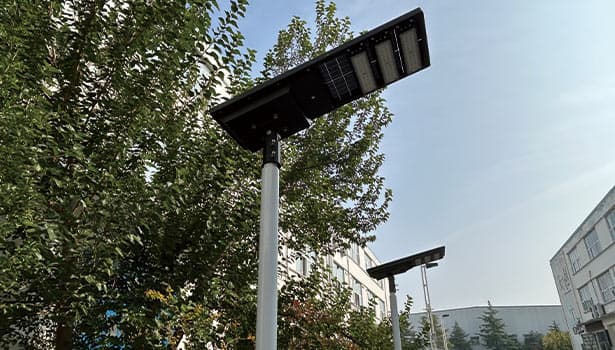
4 Steps to Select Suitable Solar Street Lights for Residential Areas
Scene and Illuminance Requirement Assessment
First, the core requirements need to be determined based on the installation scenario. The illuminance, pole height and spacing requirements vary significantly in different areas.
Scene type Lighting Requirements Description Illuminance requirements (lux) Suggested Pole height (meters) Suggested Spacing (meters)
The pedestrian walkway mainly meets the lighting needs of residents for night walking. 10-20, 3-4, 15-20
The parking lot ensures the safety of vehicle parking and pedestrians. 20-30 4-5 12-15
The main road (the main passage within the community) has a relatively large flow of people and vehicles. 30-50 5-6 20-25
Selection of Solar Panels
The core parameters of solar panels determine the charging efficiency. The following three points need to be given special attention:
Peak power
The peak power should be determined comprehensively based on the power of the LED light, the capacity of the battery and the local duration of sunlight to avoid "insufficient power leading to poor battery life" or "excessive power causing waste".
Conversion efficiency
The conversion efficiency directly affects the charging capacity under the same installation area and should be selected based on the space at the top of the light post: The conversion efficiency of monocrystalline silicon solar panels can reach 22%-24%, significantly higher than that of polycrystalline silicon at 18%-20%. Although the cost of monocrystalline silicon is slightly higher, in the long term, it can reduce the maintenance cost caused by insufficient charging.
Temperature coefficient
Most street lights in residential areas are installed in open-air environments. At noon in summer, the surface temperature of solar panels can reach over 60℃. High temperatures can easily lead to power attenuation, so high-temperature resistant products need to be selected through temperature coefficient screening.
Battery Selection
The battery is a key component that affects the lifespan and maintenance cost of the system. The two mainstream types each have their advantages and disadvantages, and the choice should be made based on the budget and usage requirements.
|
Comparison Item |
LiFePO₄ Battery |
Lead-Acid Battery |
|
Cycle Life |
2,000–3,000 cycles (approximately 8–10 years) |
500–800 cycles (approximately 3–5 years) |
|
Maintenance Requirements |
Maintenance-free; no need to add water or replenish fluid |
Requires regular electrolyte checks; high maintenance frequency |
|
Safety and Stability |
Excellent safety and thermal stability; less likely to bulge or catch fire, but performs poorly at low temperatures |
Prone to leakage at high temperatures; lower overall safety performance |
|
Size and Weight |
Compact and lightweight, easy to install |
Large and heavy, increases load on the light post |
|
Cost |
Higher unit cost; initial investment about twice that of lead-acid batteries |
Lower unit cost; smaller initial investment |
Suggestion: If the budget is sufficient and long-term low maintenance is pursued, lithium iron phosphate batteries should be given priority. If the budget is limited and regular maintenance is acceptable, lead-acid batteries can be a transitional option, but the replacement cost for 3 to 5 years later needs to be planned in advance.
LED and Optical Design
The performance of LED lights directly affects the lighting experience. The following core parameters need to be paid attention to:
- Luminous flux (lumens) : The higher the luminous flux of an LED, the wider its illumination range.
- Color Rendering Index (CRI) : The higher the CRI, the more realistic the color reproduction of objects.
- Light distribution curve: The "bat-wing" light distribution curve is preferred. The light can be evenly distributed on the ground, reducing the upward light and avoiding light pollution that affects residents' rest at night. At the same time, avoid choosing "narrow light distribution" products to prevent blind spots in lighting.
- Energy-saving mode: Products that support triple control of "light control + time control + human body sensing" are superior. For instance, it maintains 100% brightness from the evening until 10 p.m., automatically drops to 30% brightness after 10 p.m., and returns to 100% brightness when pedestrians are detected, balancing energy conservation and safety.
Controller and Intelligent Functions
The function of the controller directly affects the stability and intelligence level of the system and requires special attention:
- Basic functions: The controller must be equipped with four core functions: overcharge protection, overdischarge protection, short-circuit protection, and reverse connection protection to prevent damage to the battery and photovoltaic modules.
- Control mode: Supports three modes: light control, time control, and human body sensing, which can be flexibly switched according to the needs of the community.
- Intelligent expansion: If the community is large in scale, it is recommended to choose a controller that supports IoT remote monitoring. Through the mobile phone or computer platform, the voltage, current and lighting status of each street lightcan be viewed in real time. When a fault occurs, an alarm message will be automatically pushed to reduce the cost of manual inspection.
Quality and Certification
Quality and certification are the keys to ensuring the long-term stable operation of the system. When purchasing, the following information should be verified: the protection level, certification marks, and material of the light post of the solar street light, the controller, and each component. At the same time, it is required that the solar street light manufacturer provide a clear quality guarantee commitment to protect your own rights and interests to the greatest extent.
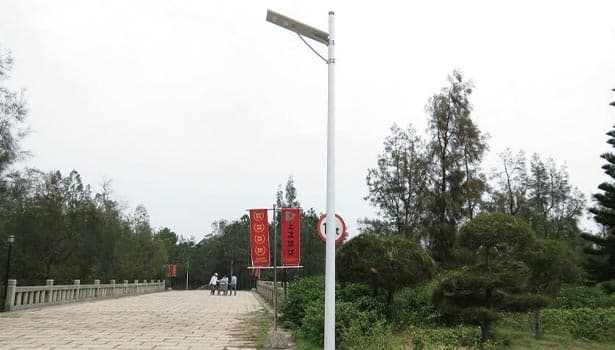
The Installation Process of Solar Street Lights in Residential Areas
Selection of Solar Street Light Locations
The selection of locations is the key to determining the endurance of solar street lights. Two core conditions must be met to avoid the loss of charging efficiency:
Unobstructed requirements: The installation area of photovoltaic panels should avoid obstructions such as trees, buildings, and other light posts. In particular, it is necessary to ensure that there is no obstruction from 9 a.m. to 3 p.m. Measured data shows that if there is obstruction during this period, the daily charging volume will drop by more than 30%, directly affecting the battery life on rainy and cloudy days.
Orientation and tilt Angle design: For photovoltaic panels in the Northern Hemisphere, they must strictly face south. The recommended tilt Angle is ±5° of the local latitude to maximize the reception of direct sunlight. If there is a slight obstruction in the installation area, the inclination Angle can be appropriately raised by 5° to 10° to reduce the impact of obstruction.
Foundation and Light Pole Installation
The installation of the foundation and light posts should take into account both "structural stability" and "equipment protection". The core steps are as follows:
Foundation construction: The dimensions should be designed based on the height of the light post and the local maximum wind speed to prevent toppling caused by typhoons or strong winds.
Installation details of the light post: During installation, use a level to calibrate in real time. The vertical deviation of the light post should not exceed 3° to avoid uneven light reception by the photovoltaic panel due to tilting. The grounding electrode must be reliably connected to the light post, with a grounding resistance of no more than 4Ω, to prevent lightning strikes from damaging core components such as the controller and battery.
Debugging
After installation is completed, three core debugging tasks need to be carried out:
The first step is to adjust the Angle of the photovoltaic panels. Use an inclinometer to confirm that the Angle meets the design requirements.
The second is the charge and discharge test. During the day, observe the charging current displayed on the controller to ensure it meets the power requirements of the solar panel. At night, check the brightness and lighting time of the lights to verify if they meet the design requirements.
The third is the intelligent function test, which triggers the human body sensing function to confirm whether the brightness switching is sensitive and whether the remote monitoring function can obtain data normally.
Regulations and Approvals
If solar street lights are installed on public roads within the community or in areas close to municipal roads, it is necessary to communicate with the local urban management and municipal departments in advance to obtain installation permits. In some areas, there are clear regulations on the height, brightness and color of street lights. It is necessary to confirm and adjust the plan in advance to avoid being required to rectify due to compliance issues after installation.
Solar Street Lights in Residential Areas Maintenance and Troubleshooting
The key points of maintaining solar street lights lie in "regular maintenance + timely inspection". Through scientific management, the system's lifespan can be extended to over 10 years, while also reducing operation and maintenance costs.
Daily/Periodic Maintenance
Formulate a regular maintenance plan. The core contents and frequencies are as follows:
- Photovoltaic panel cleaning: Clean once every three months. If the area has a lot of dust and little rainfall, the cleaning time should be shortened to 1-2 months. When cleaning, use a soft cloth and clean water. Avoid using corrosive cleaning agents to prevent scratching the panel and affecting the light transmittance.
- Battery inspection: Check every six months to see if there are any bulges or leaks on the battery casing and if the battery voltage displayed on the controller is normal.
- Inspection of lights and circuits: Check the sealing of the lights every six months to see if there is any water ingress or fogging. At the same time, check if the circuit joints are loose to avoid malfunctions caused by poor contact.
- Controller log viewing: If remote monitoring is supported, check the operation log once a month to analyze whether the charging efficiency and lighting time are normal, and promptly detect abnormal data.
Common Faults and Troubleshooting
When encountering faults, you can follow the steps below to troubleshoot. Most problems can be solved on the spot
|
Fault Phenomenon |
Possible Causes |
Troubleshooting and Solutions |
|
The light does not turn on at night |
- Controller failure - Disconnected circuit - Battery discharged |
- Check the battery voltage on the controller; if it is below 11V, recharge the battery. - Replace the controller to test whether it functions properly. - Inspect and tighten all line connections. |
|
Brightness has significantly decreased |
- Photovoltaic panels are blocked or dirty - Battery aging - LED beads degraded |
- Clean the photovoltaic panels and remove any obstructions. - Test the battery capacity; if it is below 60% of the rated value, replace the battery. - Replace the LED beads to restore brightness. |
|
The light flickers frequently |
- Poor circuit contact - Incorrect controller parameters - Loose battery connection |
- Re-tighten all line joints if voltage is unstable. - Restore controller factory settings and reconfigure parameters. - Check for loose battery connections and secure them properly. |
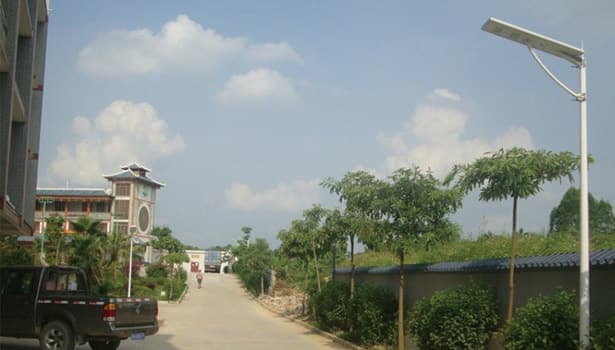
Frequently Asked Questions
Can solar street lights in residential areas work normally on rainy days?
Yes. High-quality solar street lights are designed with battery capacity based on the number of local rainy days. Most products can support continuous lighting for 3 to 7 days on cloudy and rainy days. In case of continuous rainy weather for more than 10 days, some products will automatically reduce their brightness to ensure basic lighting.
Can the photovoltaic panels of solar street lights be stolen?
The risk is relatively low First, the photovoltaic panels are installed on the top of the light posts, making it difficult to climb. Second, most manufacturers adopt anti-disassembly designs. The photovoltaic panels and light posts are fixed with special bolts and can only be disassembled with special tools. Thirdly, photovoltaic panels need to be used in conjunction with specific controllers and batteries. Once stolen separately, they are difficult to resell and have low theft value.
Which is brighter, solar street lights or traditional street lights?
Brightness depends on the LED power and luminous flux, rather than the power supply method. Under the same power, the luminous efficacy of LED lights in solar street lights is higher than that of traditional sodium lights. Therefore, the brightness of a 30W solar LED street light is equivalent to that of a 40-50W traditional sodium light, which can fully meet the lighting needs of residential areas.
Does the battery of a solar street light need to be replaced?
Necessary. Batteries are consumables. Lead-acid batteries need to be replaced every 3 to 5 years, while lithium iron phosphate batteries need to be replaced every 8 to 10 years. The replacement cost accounts for approximately 20% to 30% of the initial equipment cost, but it can continue to be used for 5 to 10 years after replacement. Overall, it is still more economical than traditional street lights.
Will the maintenance of solar street lights affect residents' life?
The impact is relatively small. Daily maintenance can be carried out during the day. When replacing the battery, power should be cut off. It takes about 30 minutes to replace a single battery. It can be done in batches to avoid large-scale lighting interruption. If remote monitoring is adopted, most faults can be warned of in advance, making maintenance more efficient and reducing on-site operation time.

